Intellectual Property Law Exam Report: Fair Dealing and Case Studies
VerifiedAdded on 2020/10/05
|12
|2484
|360
Report
AI Summary
This report examines key aspects of Intellectual Property (IP) Law, focusing on the concept of fair dealing as a permitted act under the Copyright Designs and Patents Act 1988. The report begins with an introduction to IP rights, including patents, copyrights, and trademarks, and highlights their importance in distinguishing products and services. It then presents two case studies illustrating instances of unauthorized trademark use and the legal recourse available to companies. The core of the report delves into the concept of fair dealing, outlining its definition, conditions, and exceptions, such as for research, criticism, and reporting current events. It also contrasts fair dealing with fair use and provides guidelines for its application, including factors such as the purpose of dealing, the amount of work used, and the impact on the original work. The report concludes by emphasizing the role of IP rights in business differentiation and the importance of protecting these rights through registration and legal action, while also underscoring the need for businesses to be aware of market conditions and competitor activities to safeguard their IP.
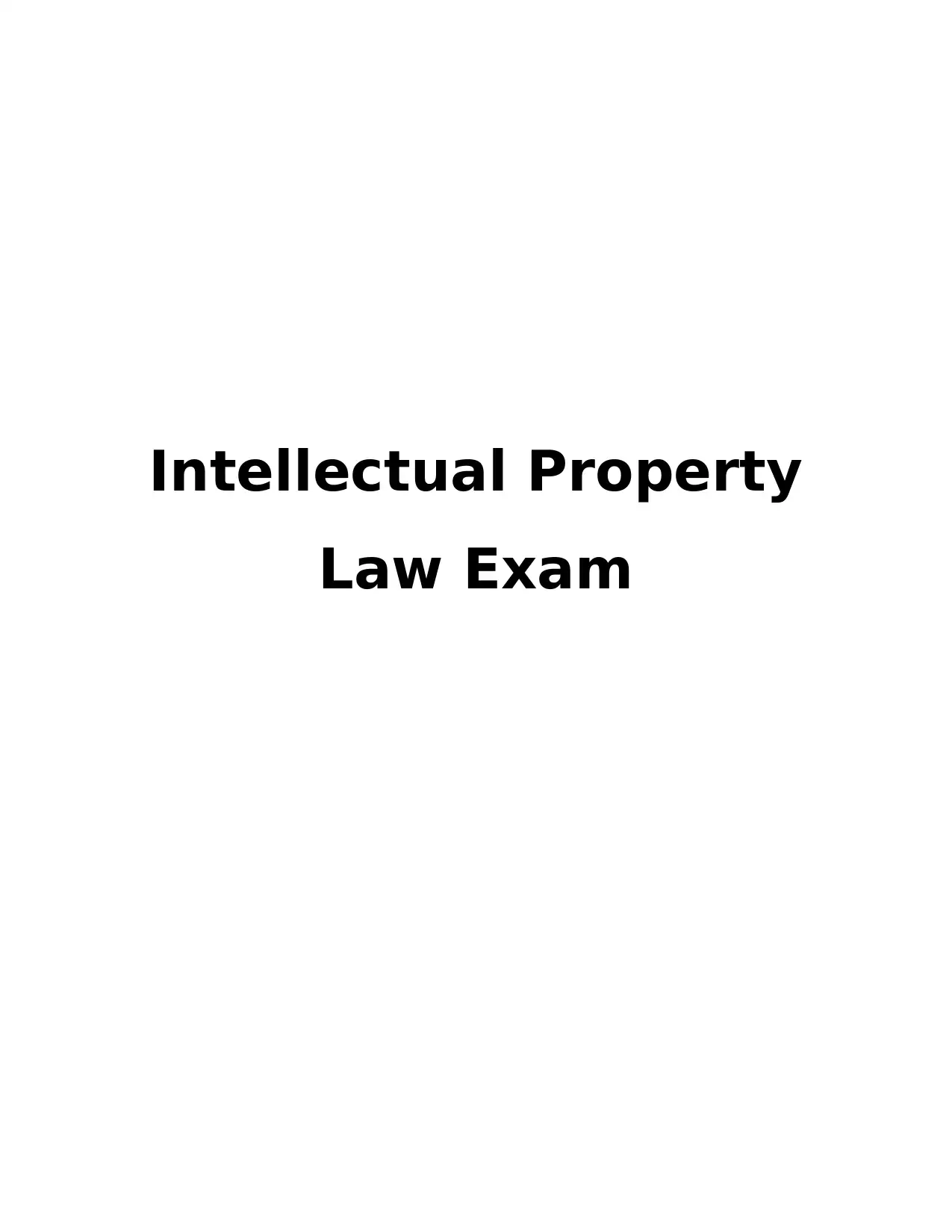
Intellectual Property
Law Exam
Law Exam
Paraphrase This Document
Need a fresh take? Get an instant paraphrase of this document with our AI Paraphraser
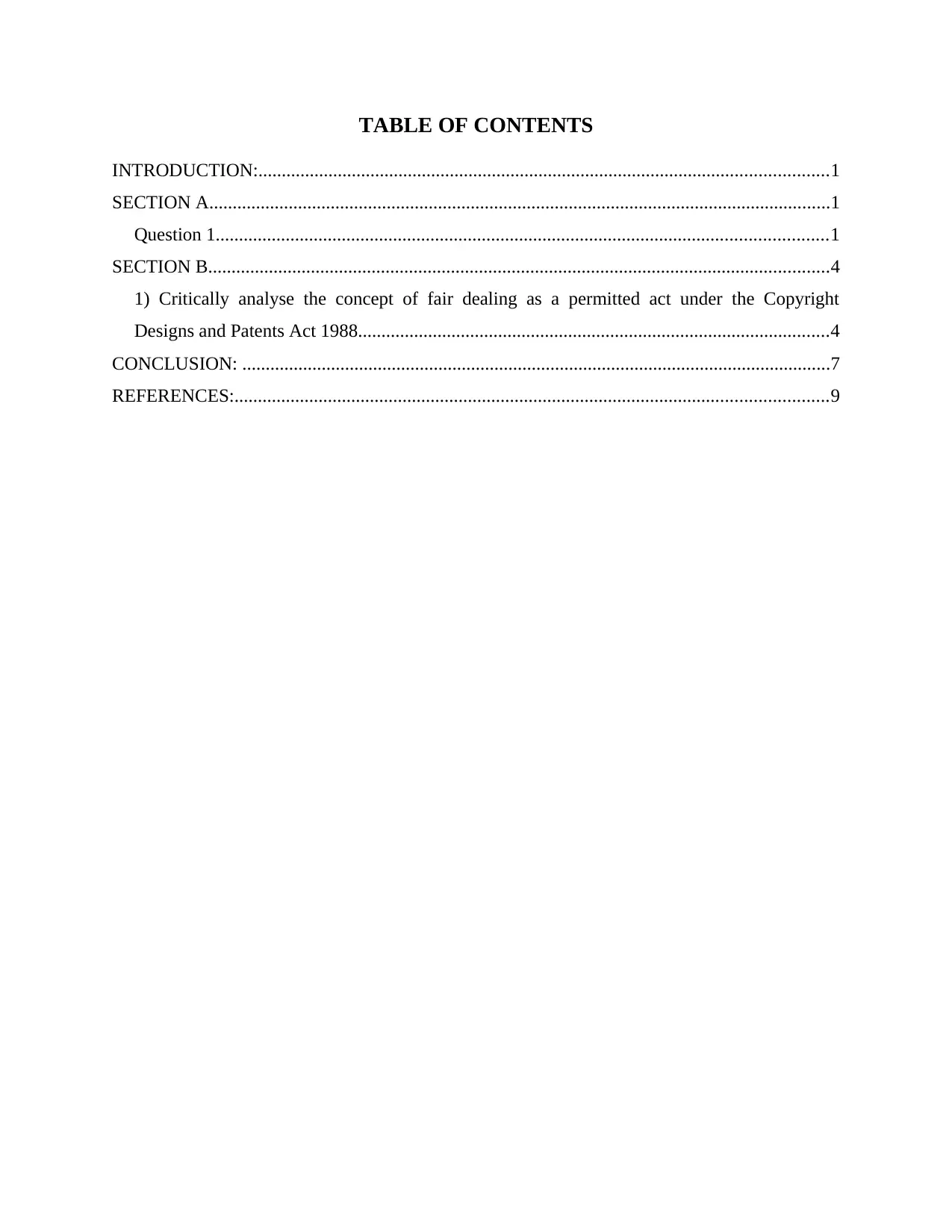
TABLE OF CONTENTS
INTRODUCTION:..........................................................................................................................1
SECTION A.....................................................................................................................................1
Question 1...................................................................................................................................1
SECTION B.....................................................................................................................................4
1) Critically analyse the concept of fair dealing as a permitted act under the Copyright
Designs and Patents Act 1988.....................................................................................................4
CONCLUSION: ..............................................................................................................................7
REFERENCES:...............................................................................................................................9
INTRODUCTION:..........................................................................................................................1
SECTION A.....................................................................................................................................1
Question 1...................................................................................................................................1
SECTION B.....................................................................................................................................4
1) Critically analyse the concept of fair dealing as a permitted act under the Copyright
Designs and Patents Act 1988.....................................................................................................4
CONCLUSION: ..............................................................................................................................7
REFERENCES:...............................................................................................................................9
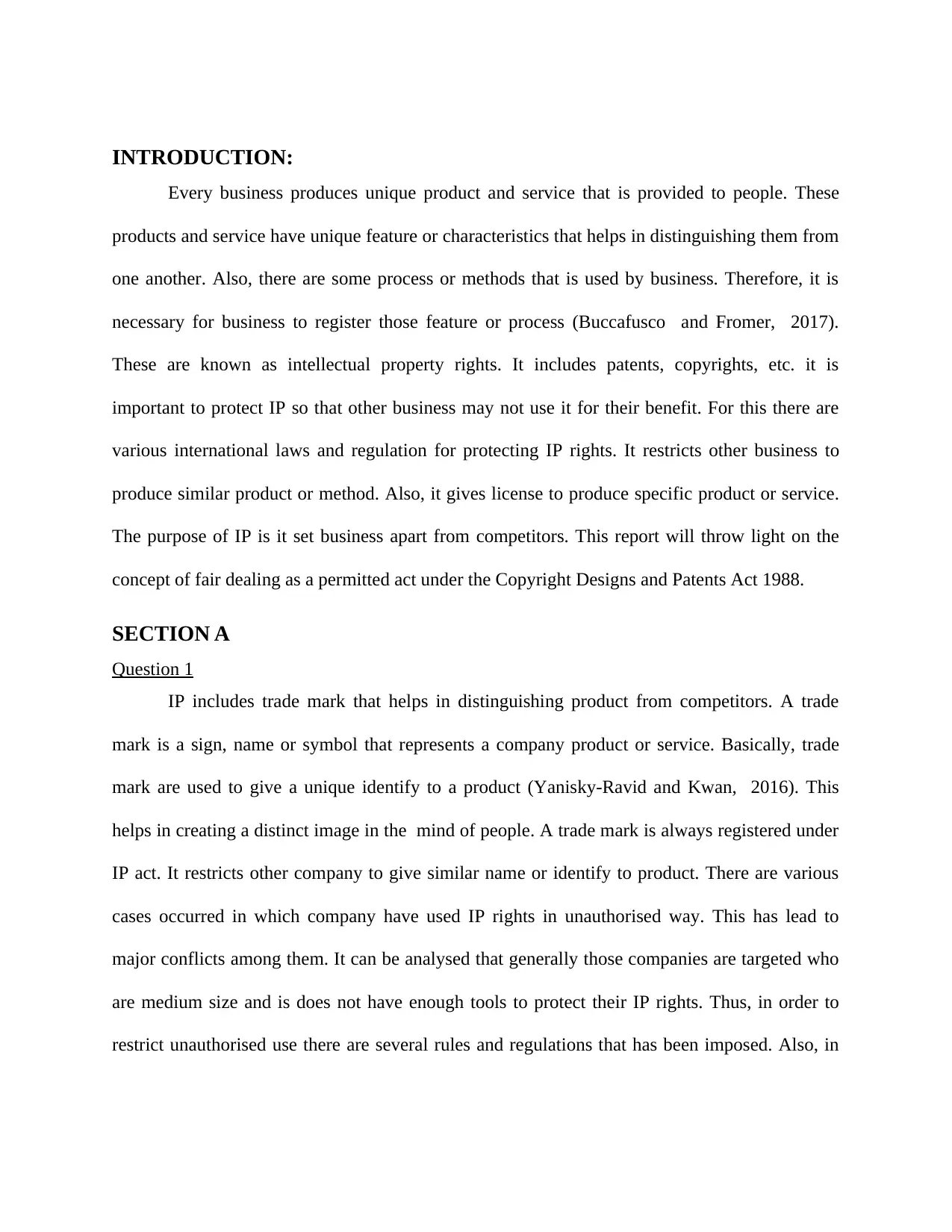
INTRODUCTION:
Every business produces unique product and service that is provided to people. These
products and service have unique feature or characteristics that helps in distinguishing them from
one another. Also, there are some process or methods that is used by business. Therefore, it is
necessary for business to register those feature or process (Buccafusco and Fromer, 2017).
These are known as intellectual property rights. It includes patents, copyrights, etc. it is
important to protect IP so that other business may not use it for their benefit. For this there are
various international laws and regulation for protecting IP rights. It restricts other business to
produce similar product or method. Also, it gives license to produce specific product or service.
The purpose of IP is it set business apart from competitors. This report will throw light on the
concept of fair dealing as a permitted act under the Copyright Designs and Patents Act 1988.
SECTION A
Question 1
IP includes trade mark that helps in distinguishing product from competitors. A trade
mark is a sign, name or symbol that represents a company product or service. Basically, trade
mark are used to give a unique identify to a product (Yanisky-Ravid and Kwan, 2016). This
helps in creating a distinct image in the mind of people. A trade mark is always registered under
IP act. It restricts other company to give similar name or identify to product. There are various
cases occurred in which company have used IP rights in unauthorised way. This has lead to
major conflicts among them. It can be analysed that generally those companies are targeted who
are medium size and is does not have enough tools to protect their IP rights. Thus, in order to
restrict unauthorised use there are several rules and regulations that has been imposed. Also, in
Every business produces unique product and service that is provided to people. These
products and service have unique feature or characteristics that helps in distinguishing them from
one another. Also, there are some process or methods that is used by business. Therefore, it is
necessary for business to register those feature or process (Buccafusco and Fromer, 2017).
These are known as intellectual property rights. It includes patents, copyrights, etc. it is
important to protect IP so that other business may not use it for their benefit. For this there are
various international laws and regulation for protecting IP rights. It restricts other business to
produce similar product or method. Also, it gives license to produce specific product or service.
The purpose of IP is it set business apart from competitors. This report will throw light on the
concept of fair dealing as a permitted act under the Copyright Designs and Patents Act 1988.
SECTION A
Question 1
IP includes trade mark that helps in distinguishing product from competitors. A trade
mark is a sign, name or symbol that represents a company product or service. Basically, trade
mark are used to give a unique identify to a product (Yanisky-Ravid and Kwan, 2016). This
helps in creating a distinct image in the mind of people. A trade mark is always registered under
IP act. It restricts other company to give similar name or identify to product. There are various
cases occurred in which company have used IP rights in unauthorised way. This has lead to
major conflicts among them. It can be analysed that generally those companies are targeted who
are medium size and is does not have enough tools to protect their IP rights. Thus, in order to
restrict unauthorised use there are several rules and regulations that has been imposed. Also, in
⊘ This is a preview!⊘
Do you want full access?
Subscribe today to unlock all pages.

Trusted by 1+ million students worldwide
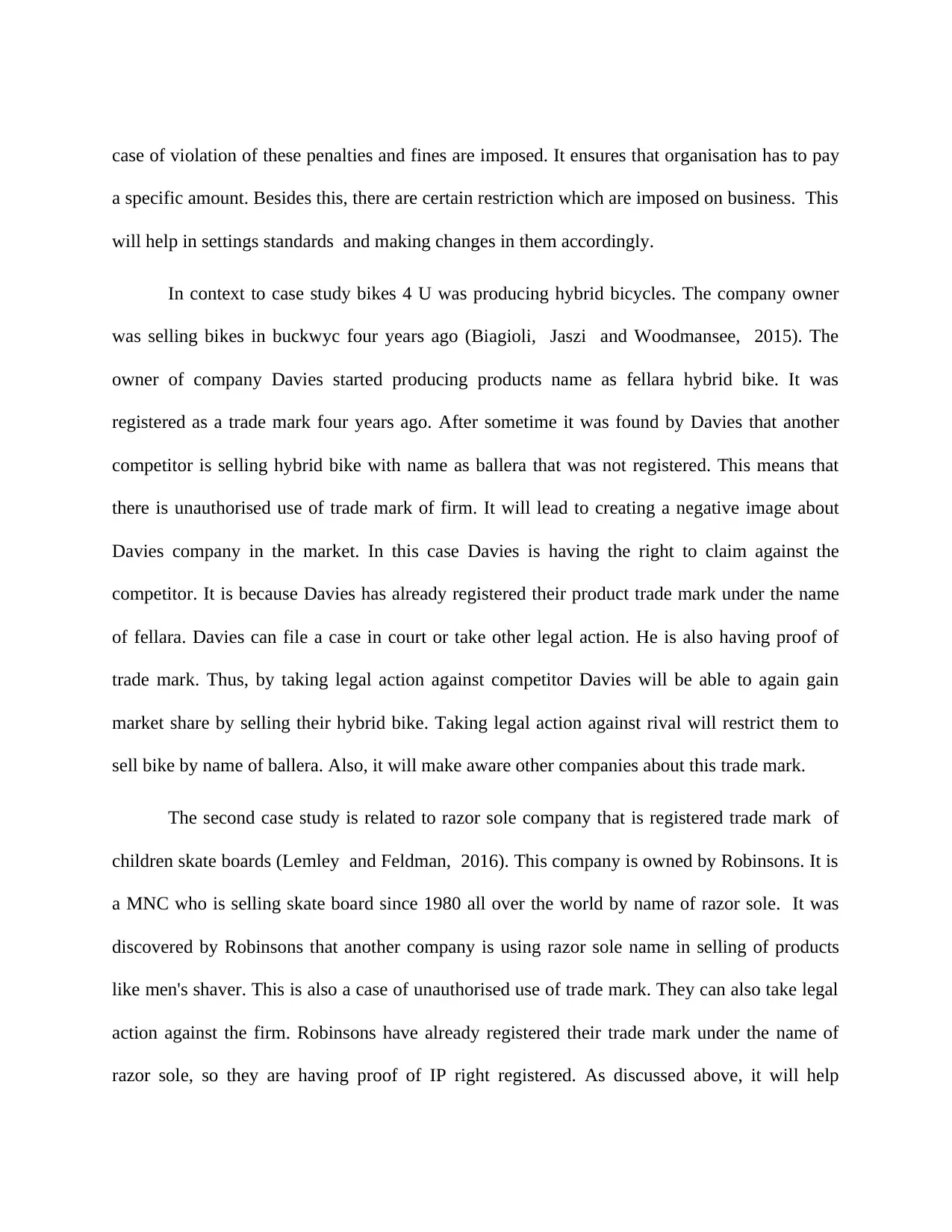
case of violation of these penalties and fines are imposed. It ensures that organisation has to pay
a specific amount. Besides this, there are certain restriction which are imposed on business. This
will help in settings standards and making changes in them accordingly.
In context to case study bikes 4 U was producing hybrid bicycles. The company owner
was selling bikes in buckwyc four years ago (Biagioli, Jaszi and Woodmansee, 2015). The
owner of company Davies started producing products name as fellara hybrid bike. It was
registered as a trade mark four years ago. After sometime it was found by Davies that another
competitor is selling hybrid bike with name as ballera that was not registered. This means that
there is unauthorised use of trade mark of firm. It will lead to creating a negative image about
Davies company in the market. In this case Davies is having the right to claim against the
competitor. It is because Davies has already registered their product trade mark under the name
of fellara. Davies can file a case in court or take other legal action. He is also having proof of
trade mark. Thus, by taking legal action against competitor Davies will be able to again gain
market share by selling their hybrid bike. Taking legal action against rival will restrict them to
sell bike by name of ballera. Also, it will make aware other companies about this trade mark.
The second case study is related to razor sole company that is registered trade mark of
children skate boards (Lemley and Feldman, 2016). This company is owned by Robinsons. It is
a MNC who is selling skate board since 1980 all over the world by name of razor sole. It was
discovered by Robinsons that another company is using razor sole name in selling of products
like men's shaver. This is also a case of unauthorised use of trade mark. They can also take legal
action against the firm. Robinsons have already registered their trade mark under the name of
razor sole, so they are having proof of IP right registered. As discussed above, it will help
a specific amount. Besides this, there are certain restriction which are imposed on business. This
will help in settings standards and making changes in them accordingly.
In context to case study bikes 4 U was producing hybrid bicycles. The company owner
was selling bikes in buckwyc four years ago (Biagioli, Jaszi and Woodmansee, 2015). The
owner of company Davies started producing products name as fellara hybrid bike. It was
registered as a trade mark four years ago. After sometime it was found by Davies that another
competitor is selling hybrid bike with name as ballera that was not registered. This means that
there is unauthorised use of trade mark of firm. It will lead to creating a negative image about
Davies company in the market. In this case Davies is having the right to claim against the
competitor. It is because Davies has already registered their product trade mark under the name
of fellara. Davies can file a case in court or take other legal action. He is also having proof of
trade mark. Thus, by taking legal action against competitor Davies will be able to again gain
market share by selling their hybrid bike. Taking legal action against rival will restrict them to
sell bike by name of ballera. Also, it will make aware other companies about this trade mark.
The second case study is related to razor sole company that is registered trade mark of
children skate boards (Lemley and Feldman, 2016). This company is owned by Robinsons. It is
a MNC who is selling skate board since 1980 all over the world by name of razor sole. It was
discovered by Robinsons that another company is using razor sole name in selling of products
like men's shaver. This is also a case of unauthorised use of trade mark. They can also take legal
action against the firm. Robinsons have already registered their trade mark under the name of
razor sole, so they are having proof of IP right registered. As discussed above, it will help
Paraphrase This Document
Need a fresh take? Get an instant paraphrase of this document with our AI Paraphraser
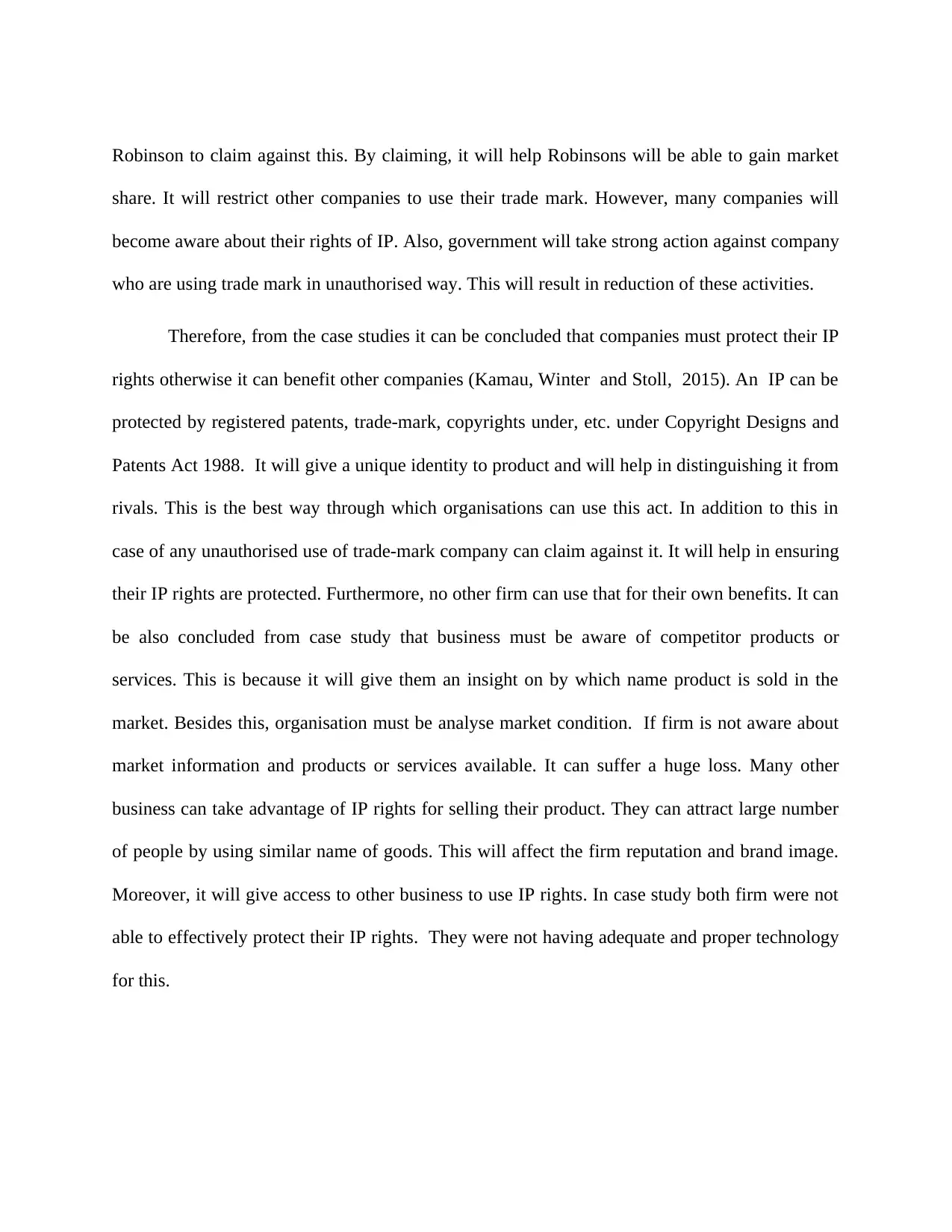
Robinson to claim against this. By claiming, it will help Robinsons will be able to gain market
share. It will restrict other companies to use their trade mark. However, many companies will
become aware about their rights of IP. Also, government will take strong action against company
who are using trade mark in unauthorised way. This will result in reduction of these activities.
Therefore, from the case studies it can be concluded that companies must protect their IP
rights otherwise it can benefit other companies (Kamau, Winter and Stoll, 2015). An IP can be
protected by registered patents, trade-mark, copyrights under, etc. under Copyright Designs and
Patents Act 1988. It will give a unique identity to product and will help in distinguishing it from
rivals. This is the best way through which organisations can use this act. In addition to this in
case of any unauthorised use of trade-mark company can claim against it. It will help in ensuring
their IP rights are protected. Furthermore, no other firm can use that for their own benefits. It can
be also concluded from case study that business must be aware of competitor products or
services. This is because it will give them an insight on by which name product is sold in the
market. Besides this, organisation must be analyse market condition. If firm is not aware about
market information and products or services available. It can suffer a huge loss. Many other
business can take advantage of IP rights for selling their product. They can attract large number
of people by using similar name of goods. This will affect the firm reputation and brand image.
Moreover, it will give access to other business to use IP rights. In case study both firm were not
able to effectively protect their IP rights. They were not having adequate and proper technology
for this.
share. It will restrict other companies to use their trade mark. However, many companies will
become aware about their rights of IP. Also, government will take strong action against company
who are using trade mark in unauthorised way. This will result in reduction of these activities.
Therefore, from the case studies it can be concluded that companies must protect their IP
rights otherwise it can benefit other companies (Kamau, Winter and Stoll, 2015). An IP can be
protected by registered patents, trade-mark, copyrights under, etc. under Copyright Designs and
Patents Act 1988. It will give a unique identity to product and will help in distinguishing it from
rivals. This is the best way through which organisations can use this act. In addition to this in
case of any unauthorised use of trade-mark company can claim against it. It will help in ensuring
their IP rights are protected. Furthermore, no other firm can use that for their own benefits. It can
be also concluded from case study that business must be aware of competitor products or
services. This is because it will give them an insight on by which name product is sold in the
market. Besides this, organisation must be analyse market condition. If firm is not aware about
market information and products or services available. It can suffer a huge loss. Many other
business can take advantage of IP rights for selling their product. They can attract large number
of people by using similar name of goods. This will affect the firm reputation and brand image.
Moreover, it will give access to other business to use IP rights. In case study both firm were not
able to effectively protect their IP rights. They were not having adequate and proper technology
for this.
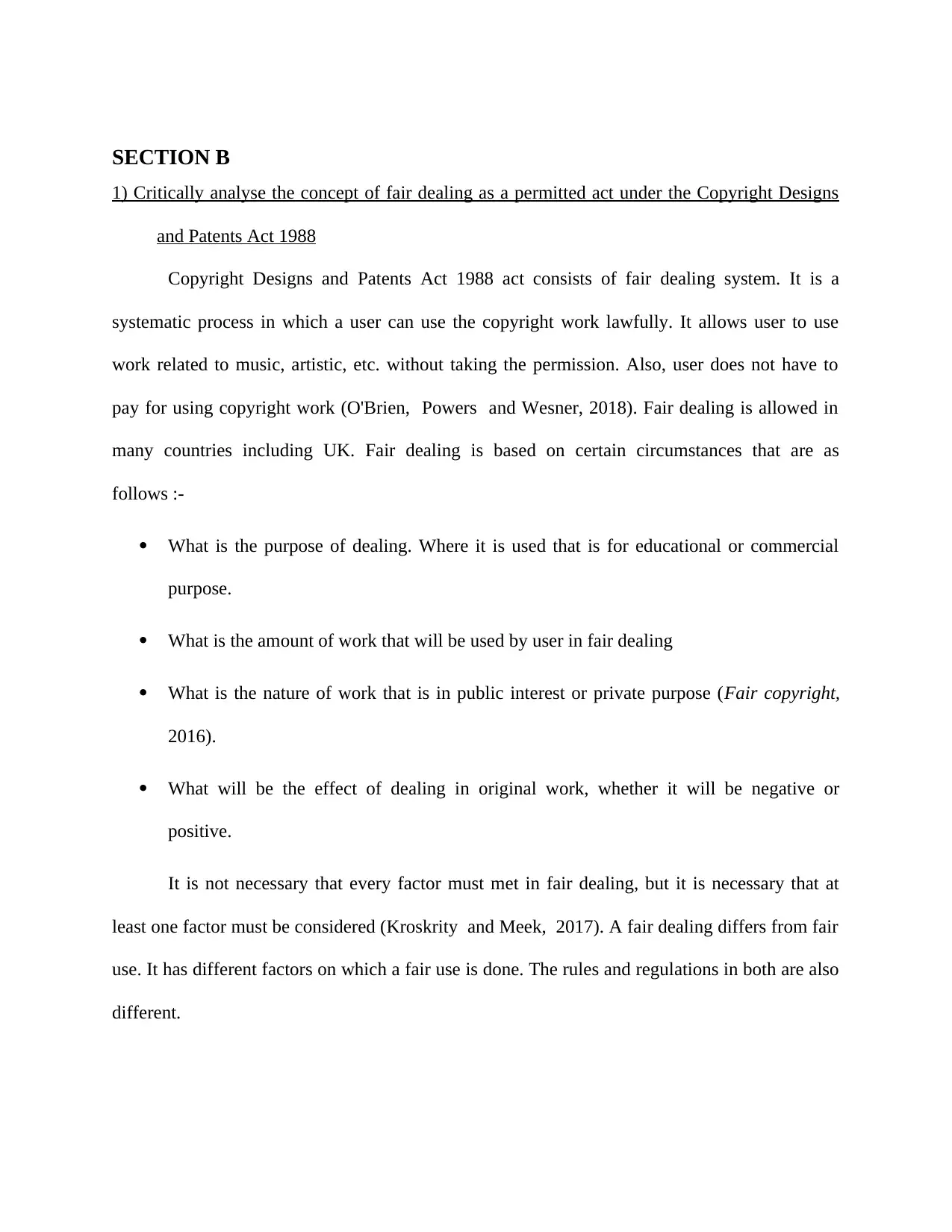
SECTION B
1) Critically analyse the concept of fair dealing as a permitted act under the Copyright Designs
and Patents Act 1988
Copyright Designs and Patents Act 1988 act consists of fair dealing system. It is a
systematic process in which a user can use the copyright work lawfully. It allows user to use
work related to music, artistic, etc. without taking the permission. Also, user does not have to
pay for using copyright work (O'Brien, Powers and Wesner, 2018). Fair dealing is allowed in
many countries including UK. Fair dealing is based on certain circumstances that are as
follows :-
What is the purpose of dealing. Where it is used that is for educational or commercial
purpose.
What is the amount of work that will be used by user in fair dealing
What is the nature of work that is in public interest or private purpose (Fair copyright,
2016).
What will be the effect of dealing in original work, whether it will be negative or
positive.
It is not necessary that every factor must met in fair dealing, but it is necessary that at
least one factor must be considered (Kroskrity and Meek, 2017). A fair dealing differs from fair
use. It has different factors on which a fair use is done. The rules and regulations in both are also
different.
1) Critically analyse the concept of fair dealing as a permitted act under the Copyright Designs
and Patents Act 1988
Copyright Designs and Patents Act 1988 act consists of fair dealing system. It is a
systematic process in which a user can use the copyright work lawfully. It allows user to use
work related to music, artistic, etc. without taking the permission. Also, user does not have to
pay for using copyright work (O'Brien, Powers and Wesner, 2018). Fair dealing is allowed in
many countries including UK. Fair dealing is based on certain circumstances that are as
follows :-
What is the purpose of dealing. Where it is used that is for educational or commercial
purpose.
What is the amount of work that will be used by user in fair dealing
What is the nature of work that is in public interest or private purpose (Fair copyright,
2016).
What will be the effect of dealing in original work, whether it will be negative or
positive.
It is not necessary that every factor must met in fair dealing, but it is necessary that at
least one factor must be considered (Kroskrity and Meek, 2017). A fair dealing differs from fair
use. It has different factors on which a fair use is done. The rules and regulations in both are also
different.
⊘ This is a preview!⊘
Do you want full access?
Subscribe today to unlock all pages.

Trusted by 1+ million students worldwide
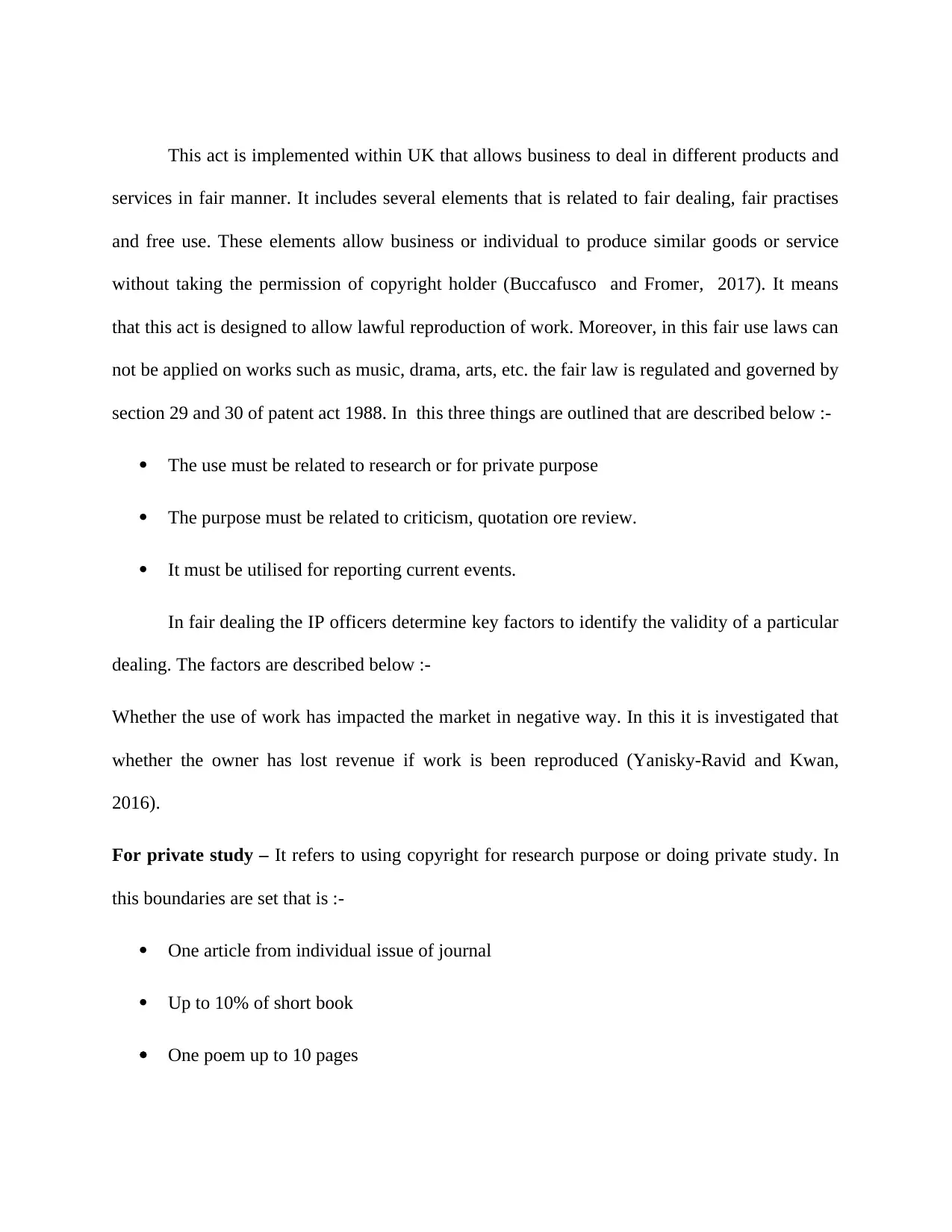
This act is implemented within UK that allows business to deal in different products and
services in fair manner. It includes several elements that is related to fair dealing, fair practises
and free use. These elements allow business or individual to produce similar goods or service
without taking the permission of copyright holder (Buccafusco and Fromer, 2017). It means
that this act is designed to allow lawful reproduction of work. Moreover, in this fair use laws can
not be applied on works such as music, drama, arts, etc. the fair law is regulated and governed by
section 29 and 30 of patent act 1988. In this three things are outlined that are described below :-
The use must be related to research or for private purpose
The purpose must be related to criticism, quotation ore review.
It must be utilised for reporting current events.
In fair dealing the IP officers determine key factors to identify the validity of a particular
dealing. The factors are described below :-
Whether the use of work has impacted the market in negative way. In this it is investigated that
whether the owner has lost revenue if work is been reproduced (Yanisky-Ravid and Kwan,
2016).
For private study – It refers to using copyright for research purpose or doing private study. In
this boundaries are set that is :-
One article from individual issue of journal
Up to 10% of short book
One poem up to 10 pages
services in fair manner. It includes several elements that is related to fair dealing, fair practises
and free use. These elements allow business or individual to produce similar goods or service
without taking the permission of copyright holder (Buccafusco and Fromer, 2017). It means
that this act is designed to allow lawful reproduction of work. Moreover, in this fair use laws can
not be applied on works such as music, drama, arts, etc. the fair law is regulated and governed by
section 29 and 30 of patent act 1988. In this three things are outlined that are described below :-
The use must be related to research or for private purpose
The purpose must be related to criticism, quotation ore review.
It must be utilised for reporting current events.
In fair dealing the IP officers determine key factors to identify the validity of a particular
dealing. The factors are described below :-
Whether the use of work has impacted the market in negative way. In this it is investigated that
whether the owner has lost revenue if work is been reproduced (Yanisky-Ravid and Kwan,
2016).
For private study – It refers to using copyright for research purpose or doing private study. In
this boundaries are set that is :-
One article from individual issue of journal
Up to 10% of short book
One poem up to 10 pages
Paraphrase This Document
Need a fresh take? Get an instant paraphrase of this document with our AI Paraphraser
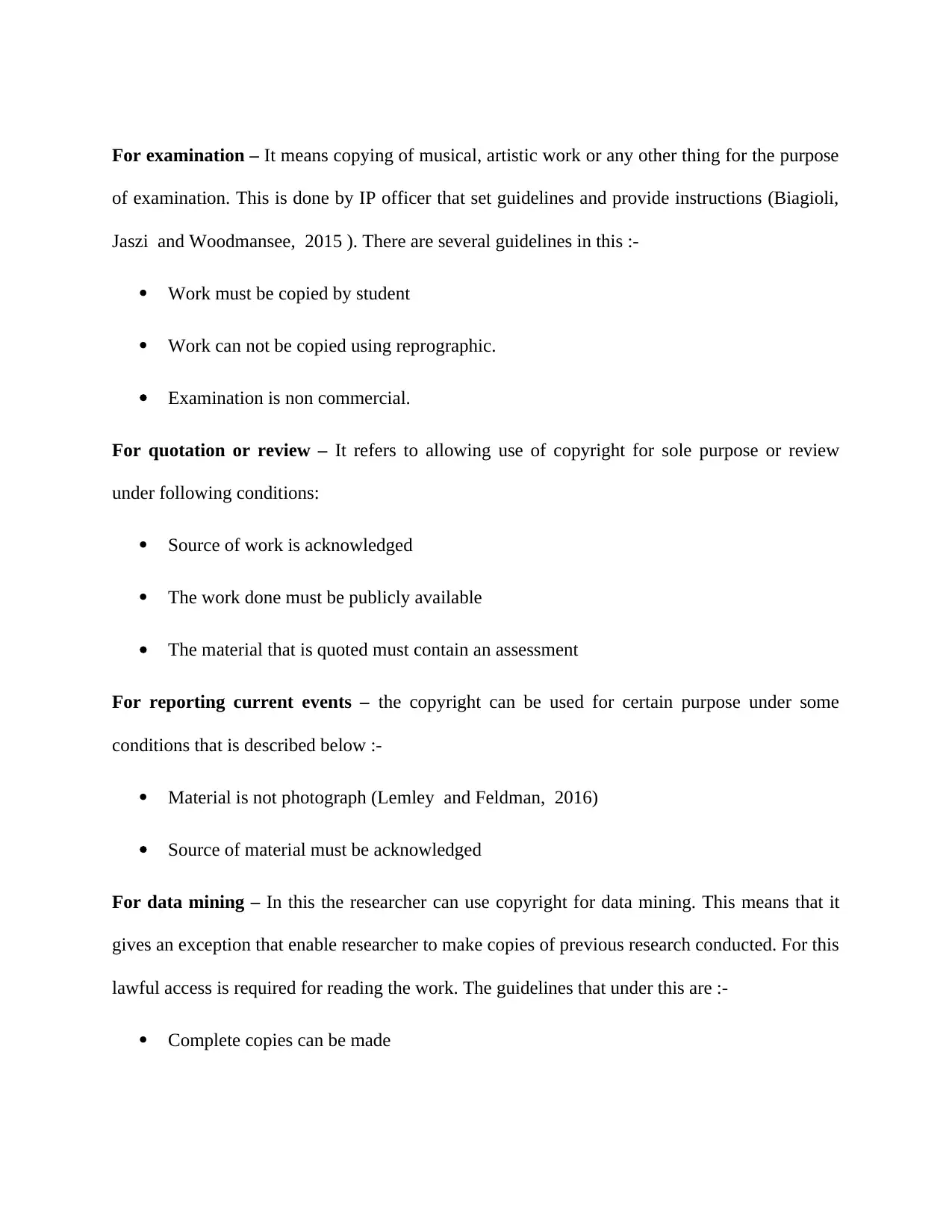
For examination – It means copying of musical, artistic work or any other thing for the purpose
of examination. This is done by IP officer that set guidelines and provide instructions (Biagioli,
Jaszi and Woodmansee, 2015 ). There are several guidelines in this :-
Work must be copied by student
Work can not be copied using reprographic.
Examination is non commercial.
For quotation or review – It refers to allowing use of copyright for sole purpose or review
under following conditions:
Source of work is acknowledged
The work done must be publicly available
The material that is quoted must contain an assessment
For reporting current events – the copyright can be used for certain purpose under some
conditions that is described below :-
Material is not photograph (Lemley and Feldman, 2016)
Source of material must be acknowledged
For data mining – In this the researcher can use copyright for data mining. This means that it
gives an exception that enable researcher to make copies of previous research conducted. For this
lawful access is required for reading the work. The guidelines that under this are :-
Complete copies can be made
of examination. This is done by IP officer that set guidelines and provide instructions (Biagioli,
Jaszi and Woodmansee, 2015 ). There are several guidelines in this :-
Work must be copied by student
Work can not be copied using reprographic.
Examination is non commercial.
For quotation or review – It refers to allowing use of copyright for sole purpose or review
under following conditions:
Source of work is acknowledged
The work done must be publicly available
The material that is quoted must contain an assessment
For reporting current events – the copyright can be used for certain purpose under some
conditions that is described below :-
Material is not photograph (Lemley and Feldman, 2016)
Source of material must be acknowledged
For data mining – In this the researcher can use copyright for data mining. This means that it
gives an exception that enable researcher to make copies of previous research conducted. For this
lawful access is required for reading the work. The guidelines that under this are :-
Complete copies can be made
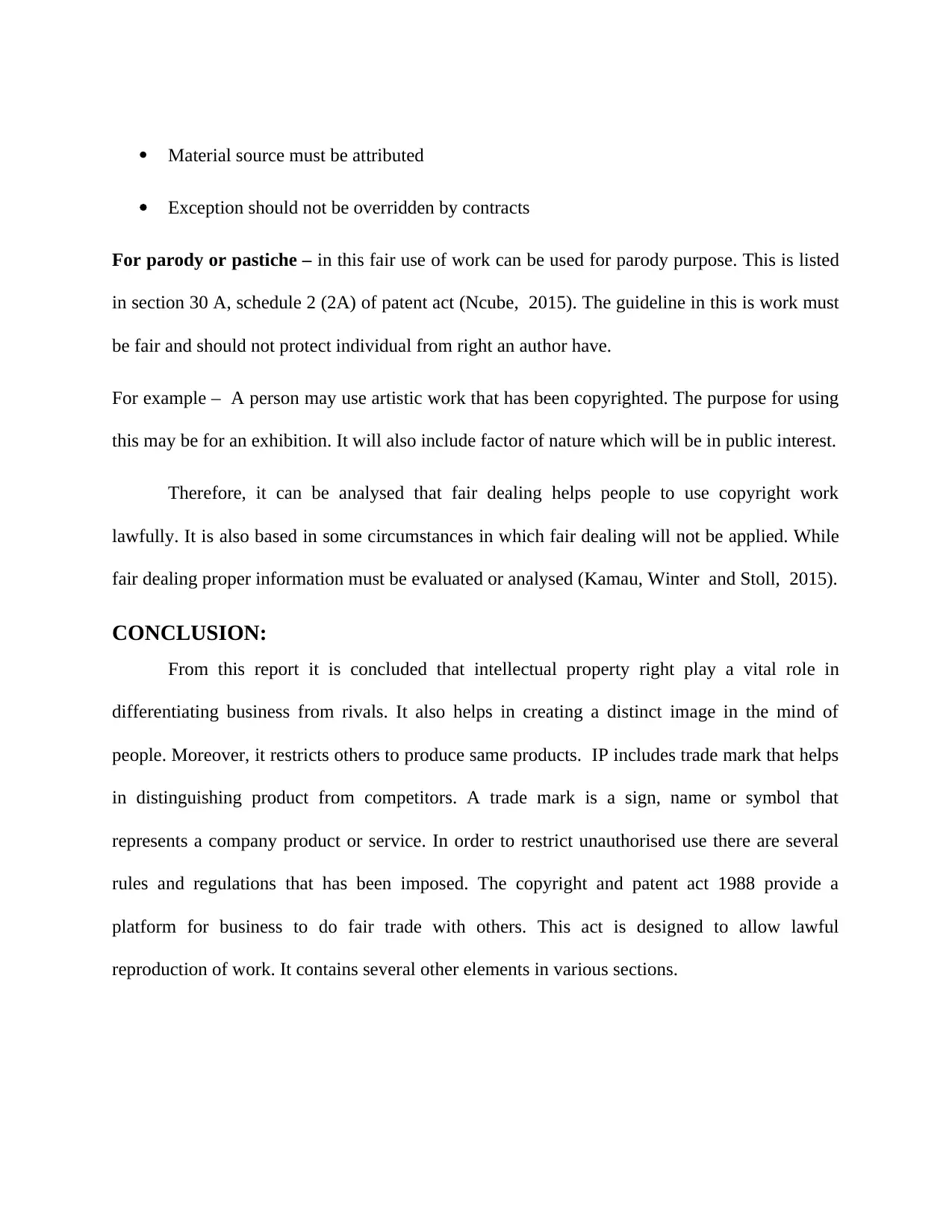
Material source must be attributed
Exception should not be overridden by contracts
For parody or pastiche – in this fair use of work can be used for parody purpose. This is listed
in section 30 A, schedule 2 (2A) of patent act (Ncube, 2015). The guideline in this is work must
be fair and should not protect individual from right an author have.
For example – A person may use artistic work that has been copyrighted. The purpose for using
this may be for an exhibition. It will also include factor of nature which will be in public interest.
Therefore, it can be analysed that fair dealing helps people to use copyright work
lawfully. It is also based in some circumstances in which fair dealing will not be applied. While
fair dealing proper information must be evaluated or analysed (Kamau, Winter and Stoll, 2015).
CONCLUSION:
From this report it is concluded that intellectual property right play a vital role in
differentiating business from rivals. It also helps in creating a distinct image in the mind of
people. Moreover, it restricts others to produce same products. IP includes trade mark that helps
in distinguishing product from competitors. A trade mark is a sign, name or symbol that
represents a company product or service. In order to restrict unauthorised use there are several
rules and regulations that has been imposed. The copyright and patent act 1988 provide a
platform for business to do fair trade with others. This act is designed to allow lawful
reproduction of work. It contains several other elements in various sections.
Exception should not be overridden by contracts
For parody or pastiche – in this fair use of work can be used for parody purpose. This is listed
in section 30 A, schedule 2 (2A) of patent act (Ncube, 2015). The guideline in this is work must
be fair and should not protect individual from right an author have.
For example – A person may use artistic work that has been copyrighted. The purpose for using
this may be for an exhibition. It will also include factor of nature which will be in public interest.
Therefore, it can be analysed that fair dealing helps people to use copyright work
lawfully. It is also based in some circumstances in which fair dealing will not be applied. While
fair dealing proper information must be evaluated or analysed (Kamau, Winter and Stoll, 2015).
CONCLUSION:
From this report it is concluded that intellectual property right play a vital role in
differentiating business from rivals. It also helps in creating a distinct image in the mind of
people. Moreover, it restricts others to produce same products. IP includes trade mark that helps
in distinguishing product from competitors. A trade mark is a sign, name or symbol that
represents a company product or service. In order to restrict unauthorised use there are several
rules and regulations that has been imposed. The copyright and patent act 1988 provide a
platform for business to do fair trade with others. This act is designed to allow lawful
reproduction of work. It contains several other elements in various sections.
⊘ This is a preview!⊘
Do you want full access?
Subscribe today to unlock all pages.

Trusted by 1+ million students worldwide
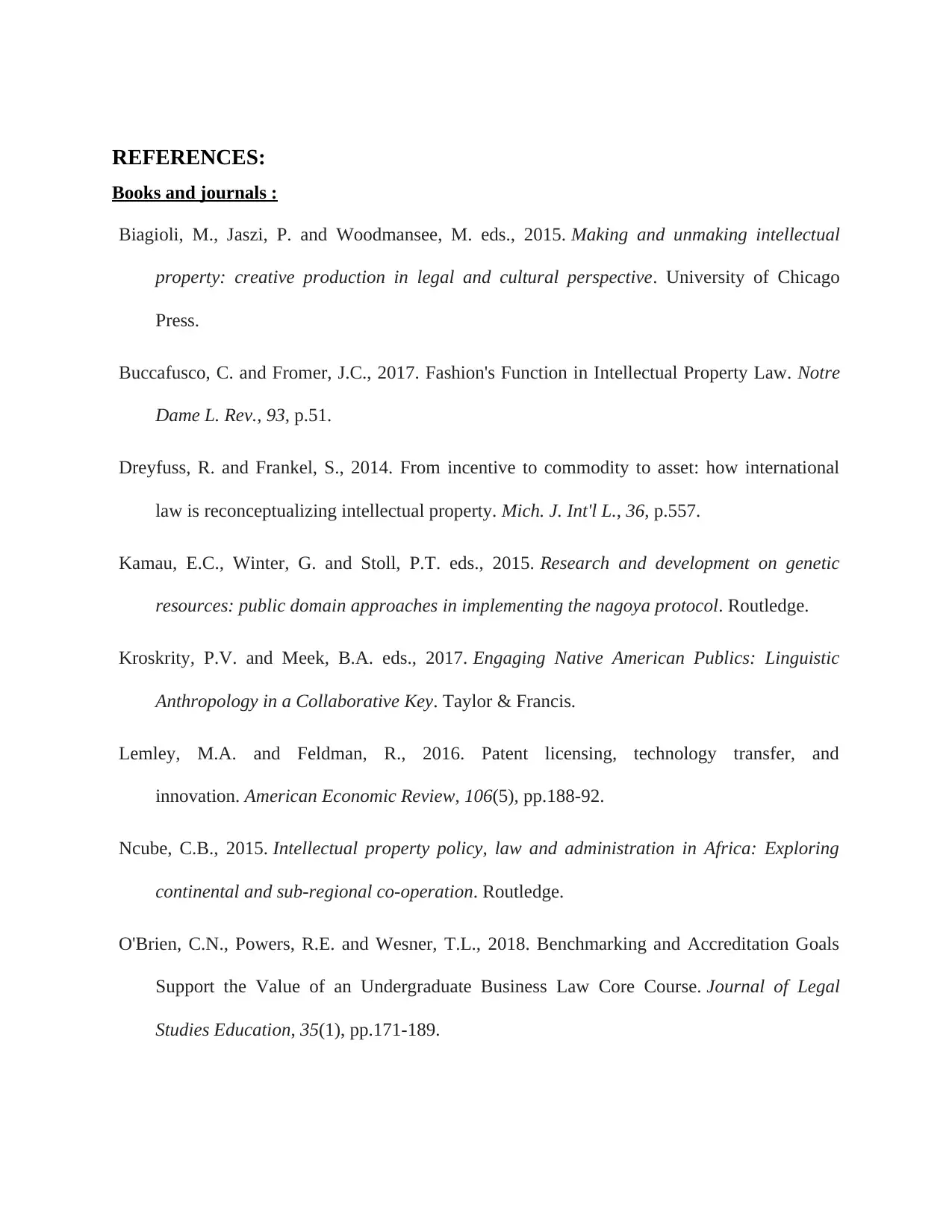
REFERENCES:
Books and journals :
Biagioli, M., Jaszi, P. and Woodmansee, M. eds., 2015. Making and unmaking intellectual
property: creative production in legal and cultural perspective. University of Chicago
Press.
Buccafusco, C. and Fromer, J.C., 2017. Fashion's Function in Intellectual Property Law. Notre
Dame L. Rev., 93, p.51.
Dreyfuss, R. and Frankel, S., 2014. From incentive to commodity to asset: how international
law is reconceptualizing intellectual property. Mich. J. Int'l L., 36, p.557.
Kamau, E.C., Winter, G. and Stoll, P.T. eds., 2015. Research and development on genetic
resources: public domain approaches in implementing the nagoya protocol. Routledge.
Kroskrity, P.V. and Meek, B.A. eds., 2017. Engaging Native American Publics: Linguistic
Anthropology in a Collaborative Key. Taylor & Francis.
Lemley, M.A. and Feldman, R., 2016. Patent licensing, technology transfer, and
innovation. American Economic Review, 106(5), pp.188-92.
Ncube, C.B., 2015. Intellectual property policy, law and administration in Africa: Exploring
continental and sub-regional co-operation. Routledge.
O'Brien, C.N., Powers, R.E. and Wesner, T.L., 2018. Benchmarking and Accreditation Goals
Support the Value of an Undergraduate Business Law Core Course. Journal of Legal
Studies Education, 35(1), pp.171-189.
Books and journals :
Biagioli, M., Jaszi, P. and Woodmansee, M. eds., 2015. Making and unmaking intellectual
property: creative production in legal and cultural perspective. University of Chicago
Press.
Buccafusco, C. and Fromer, J.C., 2017. Fashion's Function in Intellectual Property Law. Notre
Dame L. Rev., 93, p.51.
Dreyfuss, R. and Frankel, S., 2014. From incentive to commodity to asset: how international
law is reconceptualizing intellectual property. Mich. J. Int'l L., 36, p.557.
Kamau, E.C., Winter, G. and Stoll, P.T. eds., 2015. Research and development on genetic
resources: public domain approaches in implementing the nagoya protocol. Routledge.
Kroskrity, P.V. and Meek, B.A. eds., 2017. Engaging Native American Publics: Linguistic
Anthropology in a Collaborative Key. Taylor & Francis.
Lemley, M.A. and Feldman, R., 2016. Patent licensing, technology transfer, and
innovation. American Economic Review, 106(5), pp.188-92.
Ncube, C.B., 2015. Intellectual property policy, law and administration in Africa: Exploring
continental and sub-regional co-operation. Routledge.
O'Brien, C.N., Powers, R.E. and Wesner, T.L., 2018. Benchmarking and Accreditation Goals
Support the Value of an Undergraduate Business Law Core Course. Journal of Legal
Studies Education, 35(1), pp.171-189.
Paraphrase This Document
Need a fresh take? Get an instant paraphrase of this document with our AI Paraphraser
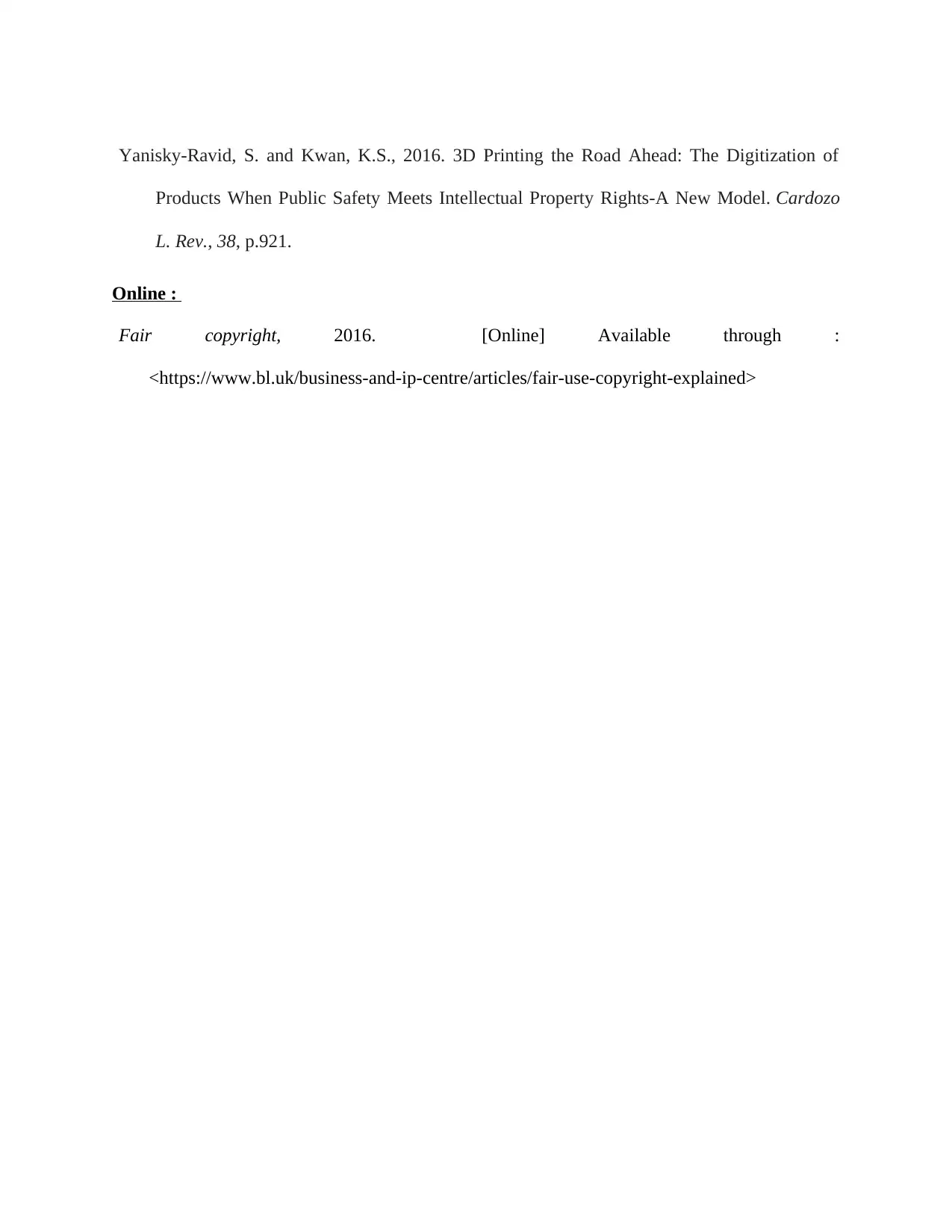
Yanisky-Ravid, S. and Kwan, K.S., 2016. 3D Printing the Road Ahead: The Digitization of
Products When Public Safety Meets Intellectual Property Rights-A New Model. Cardozo
L. Rev., 38, p.921.
Online :
Fair copyright, 2016. [Online] Available through :
<https://www.bl.uk/business-and-ip-centre/articles/fair-use-copyright-explained>
Products When Public Safety Meets Intellectual Property Rights-A New Model. Cardozo
L. Rev., 38, p.921.
Online :
Fair copyright, 2016. [Online] Available through :
<https://www.bl.uk/business-and-ip-centre/articles/fair-use-copyright-explained>

⊘ This is a preview!⊘
Do you want full access?
Subscribe today to unlock all pages.

Trusted by 1+ million students worldwide
1 out of 12
Related Documents
Your All-in-One AI-Powered Toolkit for Academic Success.
+13062052269
info@desklib.com
Available 24*7 on WhatsApp / Email
![[object Object]](/_next/static/media/star-bottom.7253800d.svg)
Unlock your academic potential
Copyright © 2020–2025 A2Z Services. All Rights Reserved. Developed and managed by ZUCOL.




